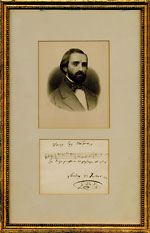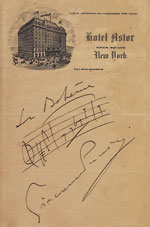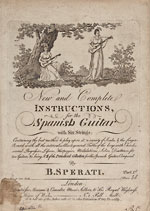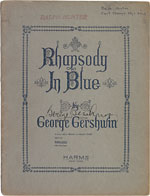Verdi and Puccini in London and New York
Musical Quotations by Giuseppe Verdi, International Autograph Auctions of Heathrow on February 13, £5,280 ($8,230) and Giacomo Puccini, Swann Galleries of New York on April 22, $4,080
Now framed up with an engraving of the composer as a youngish man, the Verdi quotation comprised three bars from one of his less familiar works, Les Vêpres Siciliennes, an opera set in thirteenth-century Sicily, where the locals are attempting to rid themselves of occupying French forces.
Verdi identifies the opera and beneath the notation has written, “La brise souffle au loin plus legeré et plus [pure],” which tells us it comes from Henri’s [or in the Italian libretto, Arrígo’s] lyrical air in Act V. It is dated London, July 23, 1855 – just six weeks after the première at the Paris Opéra. On the back of the frame is a small red leather and gilt label indicating that the quotation was once owned by one of the world’s more famous and charismatic conductors, Arturo Toscanini.
The Puccini quotation, quickly scribbled down on Hotel Astor (Times Square) notepaper, features two bars from La Bohème and probably dates from 1907, when the composer was in New York to attend Metropolitan Opera productions of Manon Lescaut and Madama Butterfly—both of them starring the great tenor, Enrico Caruso.
Spanish Guitar for 200-year-old Beginners
B. Sperati, New and Complete Instructions for the Spanish Guitar, c.1800, Bloomsbury Auctions of London on March 25, £561 ($835)
Remember those ‘Learn to Play the …’ beginner’s handbooks? Here we have a 200-year-old version, but it is only the first issue, and for a (then) quite substantial outlay of three shillings and sixpence, it seems the would-be guitar picker was getting only the first installment in a “Periodical Collection.”
Did those who bought this part from Monzani & Cimader of London see any more parts? It was not unknown for proposed part or serial publications to cease if there were not enough takers or interest shown in the first installment, but the publishers, who describe themselves as “Music Sellers to His Royal Highness the Prince of Wales,” were a respected London firm who brought a great deal of European music to Britain.
Running to just a dozen pages and engraved throughout to include fingerboard illustrations and lessons, it was catalogued as signed by the author, ‘Sperati B.,’ but few people, I think, sign themselves in such a manner, and the fact that the word guitar appears immediately above this supposed signature might also indicate a simple cataloguing note. The small stain unfortunately extends throughout the piece.
Tebaldo Monzani, I discover, was a professional flautist and flute maker, as well as publisher, and his partner, Giovanni Baptista Cimador, whose best known composition was a Double-Bass Concerto, was also an accomplished keyboard performer, arranger, and music teacher.
Ralph’s Very Own Rhapsody in Blue
George Gershwin, Rhapsody in Blue, sheet music for solo piano, 1927 or later, Swann Galleries of New York on April 22, $3,444
This much-loved work was first performed in 1924 but it was to be another three years before ambitious amateurs could lay hands on a solo piano score for the sensational piece that Gershwin had created for the Paul Whiteman Orchestra. Harms of New York first issued orchestral arrangements, then a version in which a second piano represented the orchestral parts and even Little Rhapsody in Blue, a suite of the main themes arranged for ‘easy piano’ by Honora Klarmann.
A very useful website, Classical Archives, tells me that “Gershwin felt that a solo piano version of Rhapsody in Blue would prove unplayable, and the closest he got to creating one himself was in the form of two Aeolian piano rolls of the work … In 1927, Harms did finally publish a solo piano version … created by one of its staff arrangers. As Gershwin had predicted, it was rather difficult to play, but proved hugely successful commercially.”
This undated and perhaps later issue is stamped and inscribed with the name of Ralph Hunter (1921-2002) of East Orange High School in Essex County, New Jersey, who went on to become a successful choirmaster and professor of music. Hunter made several television appearances with the conductor Toscanini and once conducted a campaign choir called Voice for Nixon, but far more significantly in saleroom terms, his copy of Rhapsody in Blue has Gershwin’s signature on the cover.








 Ian McKay’s weekly column in Antiques Trade Gazette has been running for more than 30 years.
Ian McKay’s weekly column in Antiques Trade Gazette has been running for more than 30 years.


